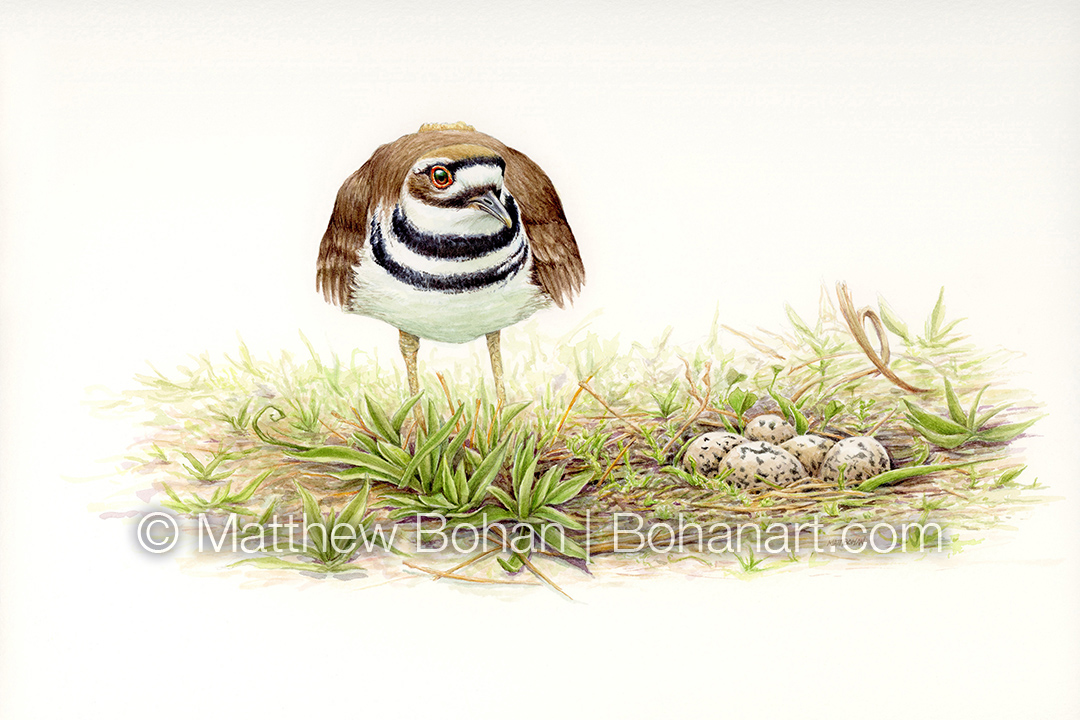
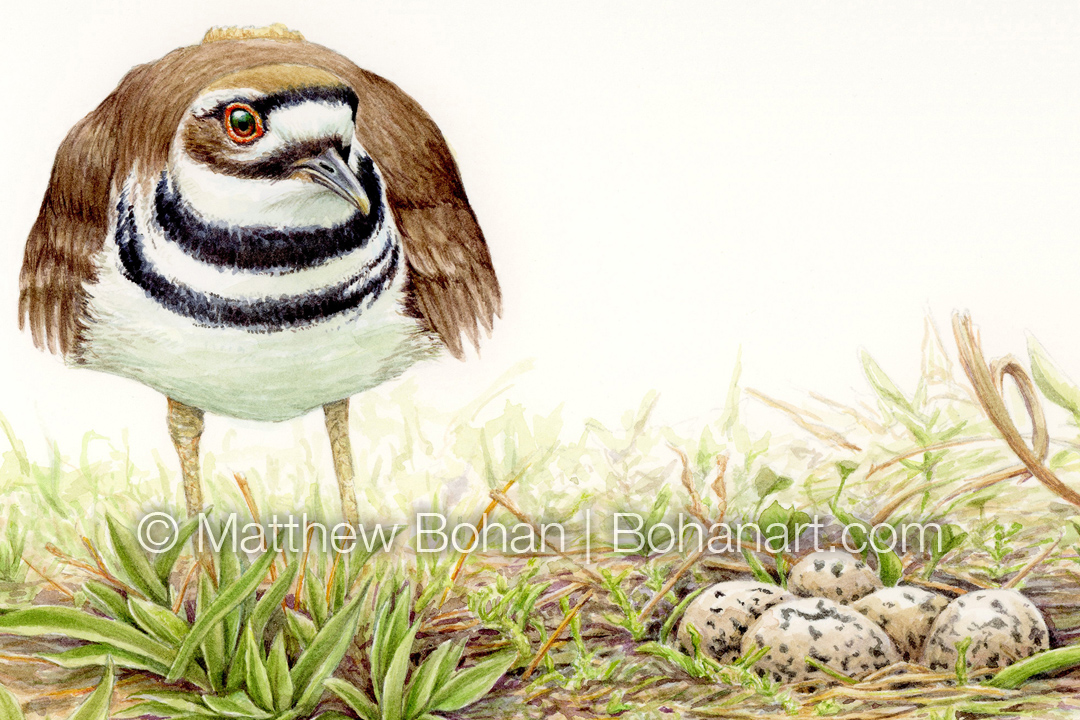
I still remember seeing my first killdeer. It was on a dog walk with my dad sometime in the 1972-74 range. We lived near a golf course in a small town in southwestern New York. He liked going for long dog walks on the golf course in the evenings after all the golfers went home. This seemed perfectly normal to a kid under 10. Back then no one carried bags to pick up the “hazardous waste” left behind. Having a Samoyed that weighed about 75 pounds meant there would have been even more to carry. I didn’t give it much of thought until I was an adult. Now I wonder how many duffers were cursing my Dad as they used a golf tee to pick out the remnants of a “tubular canine fairway hazard” from their golf shoe spikes!
Oh yeah, this is supposed to be about Killdeer! So along one edge of the course past the rough was an area that had a lot of pebbles, stone and gravel coming off the hillside. I liked walking in that area because there were cool lichens and reindeer moss. As we walked by, an injured bird hobbled off with what appeared to be a broken wing. I had just fallen for the classic Killdeer fake, and I didn’t even know what a Killdeer was yet!
My dad explained what the bird was doing, trying to lure me away from its nest among the pebbles. He told me It was called a Killdeer, named for their call. Well, he did seem to know a lot about the bird, but it was obvious to me that this one was in in terrible distress. I pleaded with him that we HAD to help the poor injured bird. My dad knew how to navigate a kid’s intellect and said something like, “Well of course we’ll bring her to help if she is truly hurt, but watch what she is going to do. She’ll draw us away from the nest, and once we follow her far enough, she will miraculously heal and fly off, eventually heading right back to where we first saw her.” Well sure enough, that is exactly what happened! At that point I thought that bird was a sneaky genius, and my dad wasn’t far behind.
My dad knew a lot about wildlife and loved the outdoors, both of which he passed down to my brothers and me. What is amazing is that until he was out of medical school and in the Air Force, he had lived his whole life in big cities. He lived in Manhattan most of his youth and did his residency in Cleveland. Later he and his brother ended up moving their families to the same small town in western New York, where they both embraced the outdoors.
My uncle is an avid hunter and expert gardener. My dad was a completely self-taught naturalist, and he seemed to know almost every wildflower, tree and shrub in the county. He collected tons of field guides, including Peterson’s Trees, Wildflowers, Insects, Rocks and Minerals, Birds, Reptiles and Amphibians, and he studied up on his new neighbors. I used those all the time as I grew up. My mom enjoyed wildlife but was less interested in putting a name to everything. Now it’s hard to think of my Dad ever having lived in a big city.
I’m not quite sure why it took so long to paint a Killdeer. They certainly are plentiful in the summers here in mid-Michigan. I think part of it was always hoping to get good photos of the parents with young chicks. They are just insanely cute and would make a fun painting. I’ve gotten a few shots like that, but the chicks were always in parking lots, not exactly the perfect setting. I’ll save that effort for down the road.
We live about a mile from a public high school. The cross-country track there has been a great place for birding and dog walks (with plastic bags!). We’ve seen all sorts of great birds there over the years, from Bald Eagles, Tundra Swans and Northern Mockingbird (pretty unusual for mid-Michigan) to Savannah Sparrows, Bobolink and Red-headed Woodpeckers. A great many regulars reside there during the breeding season, including Eastern Meadowlarks, Green Herons, Yellow Warblers, Common Yellowthroats, Eastern Kingbirds and tons of swallows and sparrows.
Every year numerous Killdeer breed there. Their favorite location is the gravel surrounding the tennis courts as well as the pole-vaulting areas. This has afforded me several opportunities to take photos of birds near their nests. The nests are nearly impossible to find, especially since the adults do their “broken wing routine” to drag you as far as possible from the actual nest. Additionally, the eggs are so well camouflaged they are almost impossible to see. In painting this I had to amp up the shadows to have them pop out a bit more than normal.
I usually try to do something new on each painting. On this one I worked on being a bit looser and lighter. I also wanted to use some subtle greens after painting a few with super intense greens. The muted colors of the Killdeer seem to work well with some understated colors in the foreground. Though common, they really are quite interesting and beautiful. That orange-red eye ring is the icing on the cake!
I almost never work on white backgrounds. In general I find them pretty boring. I liked the low depth of field in my photo reference and thought it would be fun to combine that with a fade to white in the foreground and background, leaving a band of focus. I was trying this on a new type of watercolor paper, so I was a little more willing to experiment, since I wasn’t entirely sure how it would turn out. A new surface can really throw off your technique, and for almost 20 years I’ve only used Arches 140lb HP paper.
This is the first painting I’ve done on Kilimanjaro Watercolor Paper. It’s also the first time I’ve painted birds on cold pressed paper in about 30 years. Recently, I was illustrating some cartoons in ink and watercolor for a freelance project and tried some rough cold press Strathmore paper our kids hadn’t used yet. I’m not crazy about the bumpy surface, but it takes a wash so easily, and I had fun working on it. I was down to a single sheet of my usual “go to”—Arches 140lB Hot Press Paper. I was given a block of Kilamanjaro 140lb cold press paper about five years ago and thought I’d finally give it a try to mix things up.
***
If you’d like to subscribe to my monthly newsletter for watercolor tips, techniques, resources and recommendations, sign up here.
If you’re interested in buying the original watercolor of this or another painting on this site, let me know. Prints, licensing and commissioned work are also available.
You can see more of my work on social media here.
Here are my thoughts on the Kilimanjaro paper:
- Product: I’m using a 9×12-inch 140lb Kilimanjaro Original Bright White Watercolor Block.
- Quality: It’s called Bright White, and I’d agree it is a nice, bright white paper. It isn’t super-rough, but compared to my usual Arches Hot Press, seems pretty bumpy. That being said, I didn’t find it to get in the way of putting in detail. It is smoother than a typical rough watercolor paper. It’s a great surface to work on. It seems to be a true 140lb paper and is nice and thick.
- Transfers: Doing a graphite transfer with tracing paper was harder with the textured surface.
- Washes: Being a cold press paper, it takes a wash beautifully. It is much easier to control a wash on this compared to hot press papers. It evenly wets and is very predictable. Getting smooth color and even gradients is much easier than on hot press paper. Going super soft and almost “airbrushy” smooth on this paper is great fun.
- Cost: Kilimanjaro paper is about 2/3 the cost of Arches in the same 140lb weight and tooth at Cheap Joes. I’ll use up the rest of the block and then buy a block of Kilimanjaro hot press paper to try out next.
- Scanning: All those bumps make scanning a little harder than with hot press paper. The bumps show in the scan, but not too badly.
- Acid Free: This paper is 100% cotton and acid free. Since I’ve not had the paper around for decades like the Arches paper, I can’t speak for its longevity. its quality seems high and given the materials it should hold up.
- Frisketing: The paper does seem a bit “soft” and peeled up during frisket removal on my next painting. It seems to be damaged more easily when reworking of scrubbing,
- Summary: I’d definitely recommend this Kilamanjaro product if you’re looking for a really nice cold press paper that seems to be as good as Arches.


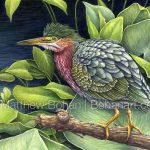
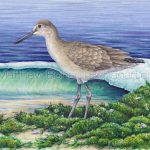
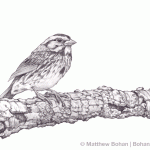


Leave a Reply